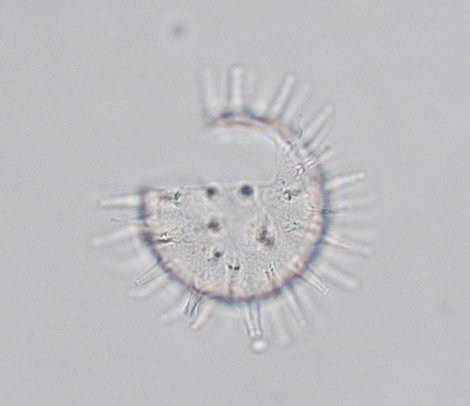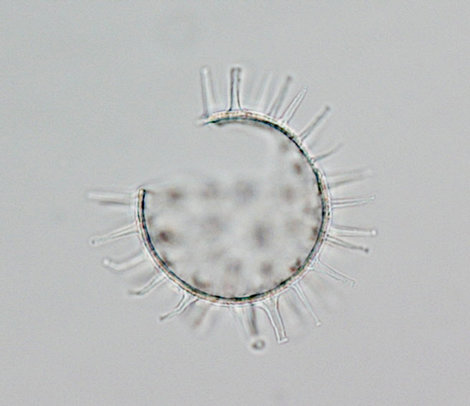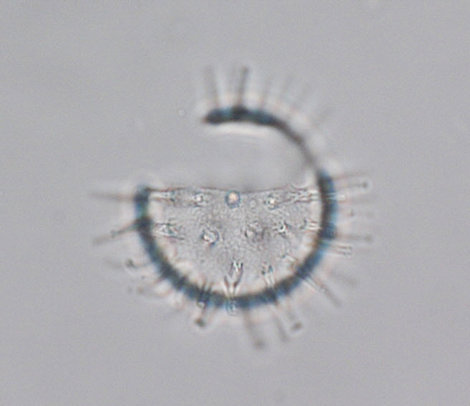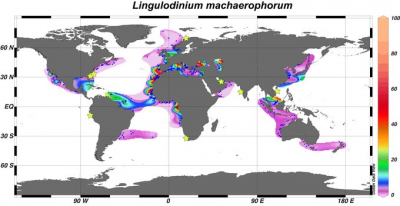Page path:
- Modern Dinocyst Key
- transparent cysts
- randomly distributed processes
- transparant cysts hollow processes
- Lingulodinium machaerophorum
Lingulodinium machaerophorum
Zonneveld, K.A.F. and Pospelova V. (2015). A determination key for modern dinoflagellate cysts. Palynology 39 (3), 387- 407.

lateral view
single grain - reference collection Bremen
Sample GeoB 9502, eastern equatorial Atlantic off NW Africa
photographs: Karin Zonneveld
single grain - reference collection Bremen
Sample GeoB 9502, eastern equatorial Atlantic off NW Africa
photographs: Karin Zonneveld

cross section

lateral view
Field characteristics
Lingulodinium machaerophorum (Deflandre and Cookson 1955) Wall 1967
Field characteristics:
Chorate spherical cyst with a microgranulate to granulate cyst wall. The randomly distributed hollow processes processes that are distally closed. The surface of the process is smooth for most of its length, but may be covered with small granules especially at their tips. The granulation of the periphragm is coarser on the conical base of the processes. The bases of the processes taper. Process form can greatly vary from short to long and from rounded to accuminate tips (Lewis and Hallett, 1997). The archeopyle is epicystal and shows a variable morphology in relation to the loss of one (type P) to 5 precingular plates.
Dimensions: Cyst body diameter: 31 to 54 µm; length of processes: 2 to 21 µm
Motile affinity: Lingulodinium polyedrum (von Stein 1883) Dodge 1989
Cyst theca relationship: Wall and Dale, 1968.
Stratigraphic range: Upper Paleocene to Recent.
Comparison with other species:
This species can be distinguished from other species by its archeopyle and process characteristics. The archeopyle often is formed by the loss of more than one paraplate. There is a large variability in size of the archeopyle with a various amount of plates that can be lost. The processes are hollow. They often have a wider basis compared to the rest of the process and they have rounded closed tops. The distal parts can be covered by small spinules. The length of the spines can vary considerably (related to physical water characteristics such as salinity). If the spines are short the spinules are seldom present. In that case, it can look very similar to Operculodinium israelianum with short spines. You can distinguish these two species by their archeopyle, and by the absence of the for O. israelianum characteristic striae.
Field characteristics:
Chorate spherical cyst with a microgranulate to granulate cyst wall. The randomly distributed hollow processes processes that are distally closed. The surface of the process is smooth for most of its length, but may be covered with small granules especially at their tips. The granulation of the periphragm is coarser on the conical base of the processes. The bases of the processes taper. Process form can greatly vary from short to long and from rounded to accuminate tips (Lewis and Hallett, 1997). The archeopyle is epicystal and shows a variable morphology in relation to the loss of one (type P) to 5 precingular plates.
Dimensions: Cyst body diameter: 31 to 54 µm; length of processes: 2 to 21 µm
Motile affinity: Lingulodinium polyedrum (von Stein 1883) Dodge 1989
Cyst theca relationship: Wall and Dale, 1968.
Stratigraphic range: Upper Paleocene to Recent.
Comparison with other species:
This species can be distinguished from other species by its archeopyle and process characteristics. The archeopyle often is formed by the loss of more than one paraplate. There is a large variability in size of the archeopyle with a various amount of plates that can be lost. The processes are hollow. They often have a wider basis compared to the rest of the process and they have rounded closed tops. The distal parts can be covered by small spinules. The length of the spines can vary considerably (related to physical water characteristics such as salinity). If the spines are short the spinules are seldom present. In that case, it can look very similar to Operculodinium israelianum with short spines. You can distinguish these two species by their archeopyle, and by the absence of the for O. israelianum characteristic striae.
Geographic distribution
Geographic distribution based on :
Zonneveld et al., 2013. Atlas of modern dinoflagellate cyst distribution based on 2405 datapoints. Review of Palaeobotany and Palynology, v. 191, 1-197
Zonneveld et al., 2013. Atlas of modern dinoflagellate cyst distribution based on 2405 datapoints. Review of Palaeobotany and Palynology, v. 191, 1-197
Lingulodinium machaerophorum can be found in temperate to equatorial environments with temperatures above 10°C in summer and 0°C in winter. It is observed in regions with a broad salinity range. Reduced process length can be observed in relationship to reduced salinity and enhanced salinities and temperatures. Highest relative abundances occur in the vicinity of the active upwelling cells and near river mouths. Seasonal production occurs when stratified upper waters develop after a time of turbulence for instance at times of upwelling relaxation.

Distribution:
Lingulodinium machaerophorum is restricted to temperate to equatorial regions of the northern hemisphere and subtropical - equatorial regions of the Southern Hemisphere with the arctic and antarctic subtropical fronts forming its northern and southern distribution boundary, respectively. With a few exceptions, it is restricted to coastal regions and regions in the vicinity of continental margins. High relative abundances can be observed in sediments near upwelling cells or below river discharge plumes e.g. those of the Congo-river, Amazon, Po and Volga or in highly stratified waters (for instance in the Black Sea and Marmara Sea). Highest relative abundance values (up to 90%) are observed in sediments of the upwelling areas off NW Africa and the Iberian peninsula in close vicinity to the active upwelling cells as well as near river mouths.
Environmental parameters:
SST: 0 - 29.8°C (winter - summer) with summer SST > 10.1°C. Exception are formed by 4 recordings where winter SST < 0°C and can go down to -1.3°C. SSS: 8.5 - 39.4 (summer - autumn), [P]: 0.06 - 1.1 μmol/l, [N]: 0.04 - 12.0 μmol/l, chlorophyll-a: 0.01 - 16.7 ml/l, [O2]: 0.3 - 7.2 ml/l.
High relative abundances of L. machaerophorum occur where high as well as low sea surface salinities exist, the latter as a result of river discharge. It is abundant in regions with strong (seasonal) variability in the trophic state of the upper waters such as upwelling areas where eutrophic conditions prevail only at times of active upwelling, upwelling relaxation or when upwelling filaments cross the sampling site and where oligotrophic conditions exist during time intervals when upwelling is reduced or absent.
Comparison with other records:
Apart from the observations included in this atlas L. machaerophorum is registered from a few coastal sites in the Benguela upwelling region off South Africa, the Peruvian upwelling area, the Gulf of Oman, along the South Atlantic coast of the eastern USA, in a fjord in northern Norway and in waters off western India (Godhe et al., 2000; Zonneveld and Marret, 2003; Joyce et al., 2005; Pitcher and Joyce, 2009; Rørvik et al., 2009 and references therein). In sediment trap and seasonal distribution studies of upwelling areas, cyst production of L. machaerophorum is typically observed during upwelling relaxation when upper waters still contain high nutrient/trace element concentrations but have become stratified (Marret and Zonneveld 2003; Susek et al., 2005; Ribeiro and Amorim, 2008; Zonneveld et al., 2010 and references therein). In Bahía Concepción (Gulf of California), cyst production of L. machaerophorum occurs when upper waters become more stratified (Morquecho and Lechuga-Devéze, 2004). In the meso/eutrophic Omura Bay (Japan) L. machaerophorum is produced sporadically throughout the year independent of seasonal variations (Fujii and Matsuoka, 2006).
Recently, Smayda (2010) suggested in an overview on dinoflagellate bloom developments in upwelling areas that the successful occurrence of L. machaerophorum in the highly variable upwelling environment might be the result of its multiple seeding behaviour. Apart from the sexual resting cysts, L. machaerophorum can produce asexual ecdysal cysts of which the production can be induced by turbulence (Figueroa and Bravo, 2005). These asexual cysts appear to protect the specimens against turbulence during upwelling and allow a fast re-colonisation of the water column upon upwelling relaxation. Comparable changes in upper water conditions can be observed in several river-plume environments as a result of varying river outflow. When river discharge increases a wedge of nutrient-rich fresh water can move off the river mouth. Turbidity is highest at the edge of such a wedge. After the edge of a wedge has passed, upper waters consist of relative fresh, nutrient-rich river plume waters that force the upper water column to become stratified.
A relationship between a reduction of process length and reduced salinities (see references in Marret and Zonneveld 2003). Culture experiments by Hallett (1999) revealed a strong relationship between processes length and salinity as well as temperature with reduced processes at high temperatures and low as well as high salinities. This relationship with both temperature and salinity has been confirmed from field observations and has proven to be a useful tool to reconstruct downcore salinity (Mertens 2009; 2012, and references therein).
Lingulodinium machaerophorum is restricted to temperate to equatorial regions of the northern hemisphere and subtropical - equatorial regions of the Southern Hemisphere with the arctic and antarctic subtropical fronts forming its northern and southern distribution boundary, respectively. With a few exceptions, it is restricted to coastal regions and regions in the vicinity of continental margins. High relative abundances can be observed in sediments near upwelling cells or below river discharge plumes e.g. those of the Congo-river, Amazon, Po and Volga or in highly stratified waters (for instance in the Black Sea and Marmara Sea). Highest relative abundance values (up to 90%) are observed in sediments of the upwelling areas off NW Africa and the Iberian peninsula in close vicinity to the active upwelling cells as well as near river mouths.
Environmental parameters:
SST: 0 - 29.8°C (winter - summer) with summer SST > 10.1°C. Exception are formed by 4 recordings where winter SST < 0°C and can go down to -1.3°C. SSS: 8.5 - 39.4 (summer - autumn), [P]: 0.06 - 1.1 μmol/l, [N]: 0.04 - 12.0 μmol/l, chlorophyll-a: 0.01 - 16.7 ml/l, [O2]: 0.3 - 7.2 ml/l.
High relative abundances of L. machaerophorum occur where high as well as low sea surface salinities exist, the latter as a result of river discharge. It is abundant in regions with strong (seasonal) variability in the trophic state of the upper waters such as upwelling areas where eutrophic conditions prevail only at times of active upwelling, upwelling relaxation or when upwelling filaments cross the sampling site and where oligotrophic conditions exist during time intervals when upwelling is reduced or absent.
Comparison with other records:
Apart from the observations included in this atlas L. machaerophorum is registered from a few coastal sites in the Benguela upwelling region off South Africa, the Peruvian upwelling area, the Gulf of Oman, along the South Atlantic coast of the eastern USA, in a fjord in northern Norway and in waters off western India (Godhe et al., 2000; Zonneveld and Marret, 2003; Joyce et al., 2005; Pitcher and Joyce, 2009; Rørvik et al., 2009 and references therein). In sediment trap and seasonal distribution studies of upwelling areas, cyst production of L. machaerophorum is typically observed during upwelling relaxation when upper waters still contain high nutrient/trace element concentrations but have become stratified (Marret and Zonneveld 2003; Susek et al., 2005; Ribeiro and Amorim, 2008; Zonneveld et al., 2010 and references therein). In Bahía Concepción (Gulf of California), cyst production of L. machaerophorum occurs when upper waters become more stratified (Morquecho and Lechuga-Devéze, 2004). In the meso/eutrophic Omura Bay (Japan) L. machaerophorum is produced sporadically throughout the year independent of seasonal variations (Fujii and Matsuoka, 2006).
Recently, Smayda (2010) suggested in an overview on dinoflagellate bloom developments in upwelling areas that the successful occurrence of L. machaerophorum in the highly variable upwelling environment might be the result of its multiple seeding behaviour. Apart from the sexual resting cysts, L. machaerophorum can produce asexual ecdysal cysts of which the production can be induced by turbulence (Figueroa and Bravo, 2005). These asexual cysts appear to protect the specimens against turbulence during upwelling and allow a fast re-colonisation of the water column upon upwelling relaxation. Comparable changes in upper water conditions can be observed in several river-plume environments as a result of varying river outflow. When river discharge increases a wedge of nutrient-rich fresh water can move off the river mouth. Turbidity is highest at the edge of such a wedge. After the edge of a wedge has passed, upper waters consist of relative fresh, nutrient-rich river plume waters that force the upper water column to become stratified.
A relationship between a reduction of process length and reduced salinities (see references in Marret and Zonneveld 2003). Culture experiments by Hallett (1999) revealed a strong relationship between processes length and salinity as well as temperature with reduced processes at high temperatures and low as well as high salinities. This relationship with both temperature and salinity has been confirmed from field observations and has proven to be a useful tool to reconstruct downcore salinity (Mertens 2009; 2012, and references therein).


